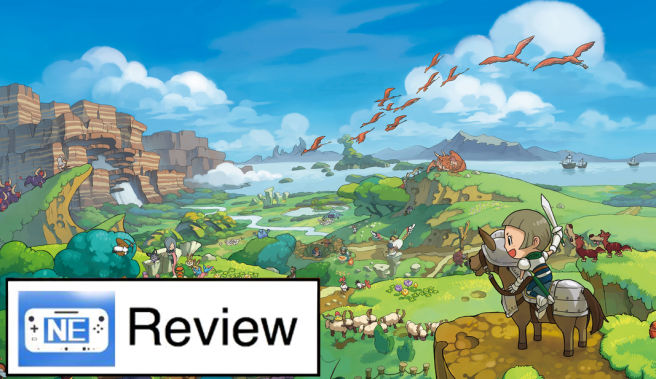[Review] Fantasy Life (3DS)
System: Nintendo 3DS
Release Date: October 24th, 2014 (NA) September 26/27, 2014 (EU/AU)
Developer: Level 5, 1-UP Studio
Publisher: Nintendo
Author: Austin
Paper Skyrim.
The defining feature of Nintendo’s Paper Mario series is, undoubtedly, its warmth. Characters and locales that are at once unbelievable and entirely lovable, supported by music that makes you forget you’re not a kid anymore, all tied together by a simple but enjoyable story of saving the kingdom from certain doom.
The defining feature of Bethesda’s Elder Scrolls series is, undoubtedly, its scope. Hundreds of quests, hundreds of hours, and a seemingly endless amount of trivial– but altogether enjoyable– gameplay to partake in.
Fantasy Life isn’t perfectly described as a combination of these two philosophies, but thinking of it in those terms would give you a fair idea of what to expect if you opted into this Level 5 adventure. It’s a tempting concept, after all: What if you could live in the world you just saved for as long as you like? What if you never had to leave those characters and locations behind after the credits had receded above the top screen of your 3DS? The possibility of harnessing the emotional weight that an adventurous tale lends to a world and then channeling it into an endless farming game (not just farming of course, but you follow) is an intriguing domain that would seemingly take a considerable amount of work to map and conquer. But Level 5 decided to grab their best cartographers and venture into the unknown, and thus Fantasy Life has burst forth onto the 3DS, covered with bruises and a few broken bones, but with a completed map of that intriguing domain nonetheless in tow.
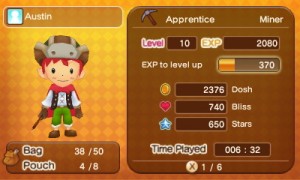
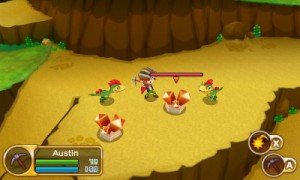
The spoken core of Fantasy Life is in its jobs system. Begin the game and you’re quickly told that you must choose a “Life”– though you could call it a job or a class or a career if you like– before being allowed to start. There are something like twelve options, from wizard to mercenary to lumberjack to miner, and they’re laid out with a confidence that makes you certain you could pick any one and not suffer undue consequence later in the game.
Having an eye for the esoteric as I do, I decided to hit rocks with a pickaxe. I was to be a miner.
How trivial the differences between job classes are largely depends on how deeply you’re willing to engage with the game, but by and large the role this option serves is trivial as far as gameplay is concerned. Because story segments require no specific skills that are only attainable by one specific class, each class is effectively equalized into being a “gathering” class: Miners gather ore, mercenaries gather enemy corpses, lumberjacks gather wood, etc etc. There’s no compelling tangible reason within the game to actually change classes because most (perhaps all) story objectives do not require any skill that all classes don’t naturally have– enemies can be avoided, ores and lumber can be ignored, etc etc. There is an inherent curiosity to the other classes though: Even if you don’t need to for story purposes, there’s joy to be had in leveling up your class or trying a new one, primarily because they set up the world to be enjoyable simply to inhabit. Curiosity blooms in organic situations.
Additionally, forcing you to start the game as a specific “Life” that has a unique duty and a unique workplace has the positive effect of familiarizing you with a select handful of specific locations, characters, and actions. You have a job, there are other people working at your job, and you have things you have to do. This is your life, in effect, and whether you like it or not is irrelevant– that the game funnels you into becoming familiar with these things early on and, like Zelda before it, juxtaposing this familiarity with the adventure that awaits lends a strength to each new location you find yourself in and each new character you meet, while building nostalgia for those places you left behind long ago. It’s a technique that people claim can boring or slow, but it’s effective at least.
Thus, the foundation for an adventure is set. Away we go.
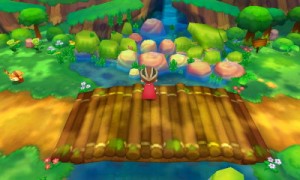
Of course, you’ll quickly come to realize that this is an adventure with sensibilities more in line with Intelligent Systems (Paper Mario, WarioWare) than Bethesda (Elder Scrolls, Fallout). Environments are welcomingly colorful and differentiated which gives them that elusive sense of warmth and nostalgia sought after by many, but the real “star of the show”– the disproportionate bearer of atmospheric weight— is the musical accompaniment provided by, as you may know, esteemed composer of all things wonderful and lovely: Nobuo Uematsu.
I’m a student of example though, so let’s give an early track from the game a listen together:
It’s a downtempo track meant to bring about that Shire-inspired feeling of “I’m home”, and by the soft sounds of the flute and the wistful backing harp, it’s fair to say that it succeeded. Most of the songs in the game manage to achieve around this level of harmony with the environments they accompany, and they do an excellent job of making the gameplay– which is fundamentally without too much depth or rhythm; it’s a vehicle for the world more than anything– entirely digestible.
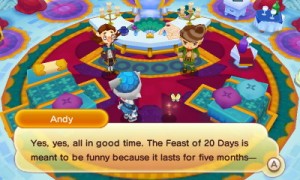
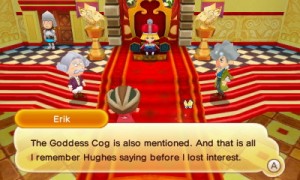
The other major success in Fantasy Life comes in the form of its writing, which presses on the strange and quirky in all of the right places. It’s laugh-out-loud funny often enough to be notable (one location in the game is called “Port Puetro”, which literally translates from Spanish to “Port Port”), but it’s also impressive because every character has a distinct voice– their own ways of being funny, or of playing off the other characters. The King– Erik, we call him– is often blunt and unperceptive, while his daughter Laura is stubborn and adventurous. The kingdom’s researcher Hughes is efficient and arrogant, but ultimately goodnatured, while your Butterfly companion is full of life and mystery. The only character that has no personality is the player character who says nary a word throughout the whole game, often to staggeringly hilarious effect. They don’t feel at all like real people measured against the rules and regulations of boring old “real life”, but I’ll be damned if these folks aren’t extremely likeable.
You can imagine how useful it is to have likeable characters in a game about adventuring and meeting likeable characters, but you can also imagine how frustrating it would be if those likeable characters spouted off an exceptionally excessive amount of tonal (rather than expository) dialogue at every opportunity you give them. Yes, this is Fantasy Life’s first major problem: Nobody knows when to stop talking. It turns likeable characters into frustrations, and it turns what could be enjoyable story-segments into speed-reading contests with yourself as you become impatient and filled with a desire to explore the wonderful world they’ve created outside. The writing is excellent– seriously excellent– but it’s also excessive.
The second thing that really puts a frustrating damper on the game’s alluring atmosphere is the existence of a bright red arrow pointing out exactly where to go at almost all moments during story chapters. Far be it from me to criticize clarity in objective in every game, but it’s absolutely fair to say that in a game like Fantasy Life, removing about half of the occurrences of this marker– particularly when your objective is, ironically, to “search” an area– would allow for quite a bit more breathing room (mostly to be used for exploring) and could, funnily enough, make those long dialogue-driven sections less overbearing as well, since there would be more time in between them. As it stands, the excessive dialogue and the flagrant use of what we call “hand-holding” do not harmonize well at all; in casual terms, the walkin’ segments don’t take long enough to support the talkin’ segments.
You know what does harmonize well? Nobuo Uematsu’s soundtrack to this game.
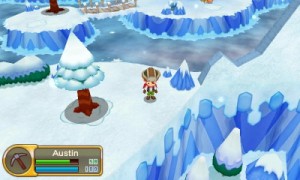

The story itself is worth at least a passing mention. Though it’s not the most sophisticated of tales, it’s at least strong enough to warrant a few tinglies in the ol’ belly as characters are separated and reunited, new friends are made, and climaxes are built up and then released. All of this is almost solely enjoyable as a side effect of quality character dialogue rather than as the direct result of a genuinely interesting or profound story, but it works nonetheless. As an interesting sidenote, the choice to make the game relatively lighthearted in tone has the poignant effect of turning otherwise plain and cliché “serious” moments into thoughts that are actually somewhat convincing. It’s a game about the power of wishes and being kind to one another, but– perhaps like a more watered-down Pixar or The Beatles– it has an underlying thread of… shall we say, believability?
You proceed through the game with a fairly well-balanced juggling of farmy sections– those bits where you do your job– and story sections. This exchange happens for 20 or 25 odd hours until the game story climaxes, the credits roll, and then, despite being “over”, the game marches onward with a whole lot of post-game content. Indeed, this might be the most interesting aspect of Fantasy Life in many ways: Build up a player’s affection for the world and these characters, and then, after an arduous journey filled with heroism and danger, settle them down into a life of furnishing their house, talking to the friends they’ve now built a relationship with, and visiting places for which there is now nostalgia or curiosity.
It’s a neat trick, and it works moderately well in the context of Fantasy Life. The biggest detriment to this is that the game pre-credits and the game post-credits aren’t all that different, though this is more of a commentary on the former than the latter: The only substantial difference is really that the post-game content sheds those inconsistent story bits, which is neither here nor there. This similarity really serves to highlight how subdued the story actually was, even if you don’t notice it while it’s going on. You’d think that in a story that characters readily call “heroic” and “perilous”, there would be a strong helping of heroism and peril… alas, not here. The decision to tell the story entirely through dialogue that’s strung together by walking means there are no moments of tension– no bosses to fight or temples to conquer or, say, fancy cinematics to build drama. Even moments that are ostensibly “exciting” are usually delivered through talking scenes or flat gameplay rather than in a way that might elicit a more visceral reaction.
And that’s really Fantasy Life’s last notable mistake: Had you created a slightly more impassioned “story-mode”, you would have not only made that part more enjoyable in its own right, but you’d have also caused the secondary part of the game to feel more relaxing, more nostalgic, and ultimately more effective. It’s a shame, but the game is easy enough to appreciate in spite of that.
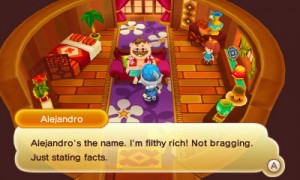
As it stands, Fantasy Life is immersive and exceptionally lovable, but feels muted by an excess of (wonderfully written) dialogue and underwhelming storytelling. Thankfully, there are genuine moments of heartfelt joy and warmth living in this wonderful and wistful world that’s filled to the brim– seriously— with simple tasks for you to do as an excuse to relax there. As far as charm is concerned, it doesn’t get much more masterclass than this, and that’s more than enough of an excuse to spend hundreds of hours completing the game’s ridiculous amount of menial sidequests.

Though it has its pitfalls in terms of execution, the novelty of attaching a massive Animal Crossing-like post-game to a passable action RPG should be worth a look for quite a number of people, particularly if you have a taste for quirky or clever dialogue. It’s an immersive game that exudes warmth and lovability from every orifice, and when you put that together with quite literally hundreds of hours of available quests– even if they are pretty shallow in and of themselves– the result tends to work on some level. If you like Paper Mario‘s humor/atmosphere and the incredible amount of fetch-quests as in Skyrim, this one is a fairly safe bet. If not, you’ll probably find it insufferably bloated.
Also: the soundtrack is just lovely.
Want to participate in more NintendoEverything goodness?
Try our Facebook page!
Or our Twitter page!
